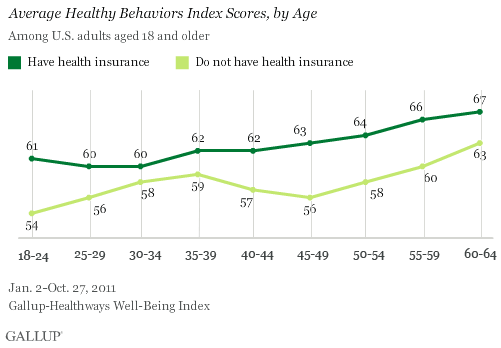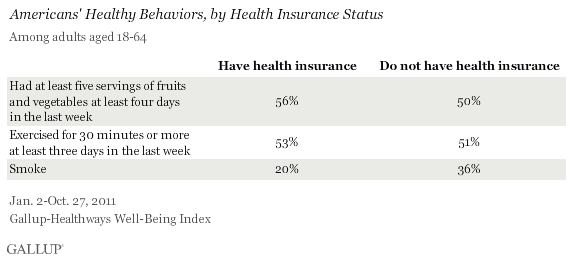This is the second in a series of articles about health insurance coverage in America among adults aged 18 to 64. Part one revealed that health insurance and health outcomes are not necessarily related.
WASHINGTON, D.C. -- Americans who have health insurance have higher Healthy Behaviors Index scores than the uninsured at any age in the 18 to 64 cohort. This holds true even after controlling for age, gender, education, ethnicity, employment, and income.

Overall, 80% of American adults younger than 65 report having health insurance coverage. This analysis is based on about 200,000 interviews conducted between January and October 2011 as part of the Gallup-Healthways Well-Being Index, which includes the Healthy Behaviors Index as a sub-component. Specifically, respondents are asked to report on whether they smoke, on how many days in the last week they exercised for at least 30 minutes, if they ate healthy all day "yesterday," and on how many days they consumed five or more servings of fruits and vegetables in the last seven days.
Insured Less Likely to Smoke, More Likely to Eat Healthy
The Centers for Disease Control and Prevention recommends people develop at least one healthy habit to increase the odds of living longer, and the Gallup results show insured Americans are already more likely than the uninsured to do so. Those with health coverage are far less likely than those without to say they smoke.
The insured are more likely than the uninsured to report eating at least five servings of produce at least four days in the last week. But in terms of physical activity, the difference between the two groups, while statistically significant, is not large.

Implications
These findings show that a relationship between health insurance coverage and good health habits exists, especially in terms of smoking. Insured Americans' better health habits may be part of the reason why they rate their overall health more positively than those who are uninsured.
Although it is still unclear why insured Americans are more likely to engage in healthy behaviors, especially when it comes to smoking, there could be various reasons to explain this. It might be that those who care about their health are already more likely to have healthy habits and have insurance coverage. Or it could be that smokers may face higher health premiums than non-smokers or might not be able to get coverage. Another possible explanation may have to do with how many Americans younger than 65 have access to wellness programs at work, as employment-based health insurance represents the largest share of coverage in this age group.
But how much influence such programs actually have on employees' health habits remains unclear. For example, Gallup research has shown that 8% of U.S. workers strongly agree their organization does things to help them improve their physical health. As such, work-based wellness programs may currently have only a small influence on insured adults' health habits. Regardless, the new federal healthcare legislation will allow employers to raise wellness program rewards (or penalties) to 30% of total premiums in 2014 with the possibility of further increases up to 50%, which could influence people's healthy behaviors.
About the Gallup-Healthways Well-Being Index
The Gallup-Healthways Well-Being Index tracks well-being in the U.S., U.K., and Germany and provides best-in-class solutions for a healthier world. To learn more, please visit well-beingindex.com.
Survey Methods
Results are based on telephone interviews conducted as part of the Gallup-Healthways Well-Being Index survey Jan. 2-Oct. 26, 2011, with a random sample of 199,672 adults, aged 18 and older, living in all 50 U.S. states and the District of Columbia, selected using random-digit-dial sampling.
For results based on the total sample of national adults, one can say with 95% confidence that the maximum margin of sampling error is ±1 percentage point. Margin of error for subgroups have a maximum margin of sampling error of ±3 percentage points.
Interviews are conducted with respondents on landline telephones and cellular phones, with interviews conducted in Spanish for respondents who are primarily Spanish-speaking. Each sample includes a minimum quota of 400 cell phone respondents and 600 landline respondents per 1,000 national adults, with additional minimum quotas among landline respondents by region. Landline telephone numbers are chosen at random among listed telephone numbers. Cell phone numbers are selected using random-digit-dial methods. Landline respondents are chosen at random within each household on the basis of which member had the most recent birthday.
Samples are weighted by gender, age, race, Hispanic ethnicity, education, region, adults in the household, and phone status (cell phone only/landline only/both, cell phone mostly, and having an unlisted landline number). Demographic weighting targets are based on the March 2010 Current Population Survey figures for the aged 18 and older non-institutionalized population living in U.S. telephone households. All reported margins of sampling error include the computed design effects for weighting and sample design.
In addition to sampling error, question wording and practical difficulties in conducting surveys can introduce error or bias into the findings of public opinion polls.
For more details on Gallup's polling methodology, visit www.gallup.com.
